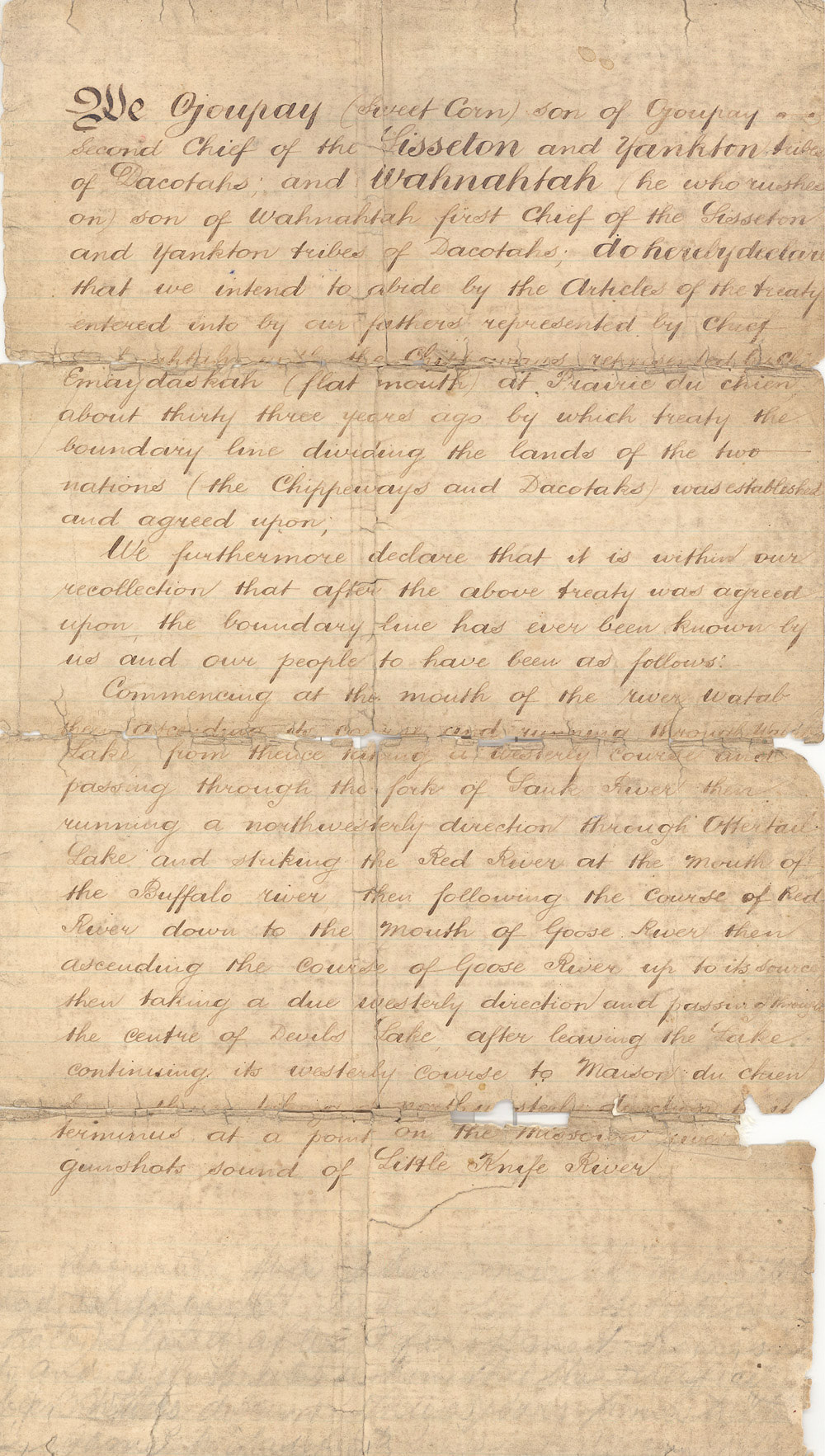|
By Kade Ferris One of the most reliable sources for defining the territory of the Pembina/Turtle Mountain Ojibwe in what is now North Dakota comes from the 1858 peace agreement, forged between the chiefs and headmen of the band and the Sisseton and Yankton Dakota, called the “Sweet Corn Treaty”. The Sweet Corn Treaty sought to establish peace and to define hunting and territorial boundaries so that there was no cause for warfare and so that resources would be shared without animosity. The Sweet Corn Treaty was read into various congressional bills throughout the late 1800s and early 1900s, and was later used in the official findings of the Indian Claims Commission. The language of the treaty stated: We, Ojoupay (Sweet Corn, son of Ojoupay), second chief of the Sisseton and Yankton tribes of Dakotas, and Wahnatah (He-who-rushes-on), son of Wahnatah, first chief of the Sisseton and Yankton tribes of Dakotas, do hereby declare that we intend to abide by the articles of the treaty entered into by our fathers, represented by Chief Wahnatah with the Chippewas, represented by Chief Emaydaskah (Flat Mouth) at Prairie du Chine, about thirty-three years ago, by which treaty the boundary line dividing the lands of the two nations (the Chippewas and Dakotas) was established and agreed upon. We further declare that it is within our recollection that after the above treaty was agreed upon the boundary line has ever been known to us and our people to have been as follows: Commencing at the mouth of the River Wahtab, thence ascending its course and running through Lake Wahtab; from thence taking a westerly course and passing through the fork of Sauk River; thence running in a northerly direction through Otter Tail Lake and striking the Red River at the mouth of Buffalo River, thence following the course of the Red River down to the mouth of Goose River, thence ascending the course of Goose River up to its source; then taking the due westerly course and passing through the center of Devils Lake at Poplar Grove; after leaving the lake, continuing its westerly course to Maison du Chine [Dogden Butte]; from thence taking a northwesterly direction to its terminus at a point near the Missouri River within gunshot sound of the Little Knife River." (US Department of Interior 1872). This general territory was later granted congressional acknowledgement in an April 18, 1876, report of the Senate Committee on Indian Affairs, which after considering a memorial from the Turtle Mountain Chippewa, reported a bill that authorized the setting aside of a reservation for the Turtle Mountain Band. In its report the committee stated: The Turtle Mountain band of Chippewa Indians, and their forefathers for many generations, have inhabited and possessed, as fully and completely as any nation of Indians on this continent have ever possessed any region of country all that tract of land lying within the following boundaries, to wit: On the north by the boundary between the United States and the British possessions; on the east by the Red River of the North: on the south their boundary follows Goose River up the Middle Fork; thence up the head of Middle Fork; thence west-northwest to the junction of Beaver Lodge and Shyenne River; thence up Shyenne River to its headwaters; thence northwest to the headwaters of Little Knife River, a tributary of the Missouri River; and thence due north to the boundary between the United States and the British possessions (Indian Claims Commission 23-315). Just a few years later (September 25, 1880), Superintendent James McLaughlin, agent at the Devils Lake Agency, wrote to the Commissioner of Indian Affairs concerning the plight of the Turtle Mountain Chippewa. He reported that white settlers were trespassing on their lands, and recommended that a reservation be set aside for them. Specifically, Agent McLaughlin reported: Inasmuch as the section of country west of the treaty line of 1863 running from Lake Chicot [Stump Lake] in a line nearly due west by Devils Lake and Dogs Den to the mouth of the Little Knife River on the Missouri, thence north to the "Roche Perce" or Hole in the Rock on the International line, thence east along the International line until its intersection with the treaty line of 1863, which tract is about 80 by 200 in extent, is recognized by all neighboring Indians as belonging to the Pembina and Turtle Mountain Bands of Chippewas, and as the same has never been ceded to the government, and the Indians being desirous to relinquish for a consideration to enable them to commence a life of agriculture, I would respectfully recommend it to the careful consideration of the Department (Indian Claims Commission 72-113). Each of the points mentioned in the above descriptions correspond to a place of importance and/or settlement associated with the Turtle Mountain Chippewa. For example, Stump Lake was the location of the village of Black Duck (Mug-a-dish-ib), a powerful sub-chief of the Ojibwe; Poplar Grove (Graham’s Island) is the location of the village of Chief Little Shell I and was also the location of a Chippewa village attacked by the Dakota in 1852; Dogden Butte was an important hunting and camping area to the Ojibwe (Indian Claims Commission 23-315). References:
United States Indian Claims Commission (ICC) (1970) Before the Indian Claims Commission. Indian Claims Commission Docket 23-315. United States General Printing Office. United States Indian Claims Commission (ICC) (1970) Before the Indian Claims Commission. Indian Claims Commission Docket 72-113. United States General Printing Office. US Congress (Department of Interior) (1872) U.S. Serial Set, Number 4015, 56th Congress, 1st Session, Pages 852 and 853. United States General Printing Office.
0 Comments
Leave a Reply. |
AuthorKade M. Ferris, MSc
Archives
June 2023
Categories |




 RSS Feed
RSS Feed
